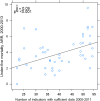Factors associated with declining under-five mortality rates from 2000 to 2013: an ecological analysis of 46 African countries
- PMID: 26747029
- PMCID: PMC4716228
- DOI: 10.1136/bmjopen-2015-007675
Factors associated with declining under-five mortality rates from 2000 to 2013: an ecological analysis of 46 African countries
Abstract
Objective: Inadequate overall progress has been made towards the 4th Millennium Development Goal of reducing under-five mortality rates by two-thirds between 1990 and 2015. Progress has been variable across African countries. We examined health, economic and social factors potentially associated with reductions in under-five mortality (U5M) from 2000 to 2013.
Setting: Ecological analysis using publicly available data from the 46 nations within the WHO African Region.
Outcome measures: We assessed the annual rate of change (ARC) of 70 different factors and their association with the annual rate of reduction (ARR) of U5M rates using robust linear regression models.
Results: Most factors improved over the study period for most countries, with the largest increases seen for economic or technological development and external financing factors. The median (IQR) U5M ARR was 3.6% (2.8 to 5.1%). Only 4 of 70 factors demonstrated a strong and significant association with U5M ARRs, adjusting for potential confounders. Higher ARRs were associated with more rapidly increasing coverage of seeking treatment for acute respiratory infection (β=0.22 (ie, a 1% increase in the ARC was associated with a 0.22% increase in ARR); 90% CI 0.09 to 0.35; p=0.01), increasing health expenditure relative to gross domestic product (β=0.26; 95% CI 0.11 to 0.41; p=0.02), increasing fertility rate (β=0.54; 95% CI 0.07 to 1.02; p=0.07) and decreasing maternal mortality ratio (β=-0.47; 95% CI -0.69 to -0.24; p<0.01). The majority of factors showed no association or raised validity concerns due to missing data from a large number of countries.
Conclusions: Improvements in sociodemographic, maternal health and governance and financing factors were more likely associated with U5M ARR. These underscore the essential role of contextual factors facilitating child health interventions and services. Surveillance of these factors could help monitor which countries need additional support in reducing U5M.
Keywords: EPIDEMIOLOGY; PAEDIATRICS; PUBLIC HEALTH.
Published by the BMJ Publishing Group Limited. For permission to use (where not already granted under a licence) please go to http://www.bmj.com/company/products-services/rights-and-licensing/
Figures


Similar articles
-
Status and drivers of maternal, newborn, child and adolescent health in the Islamic world: a comparative analysis.Lancet. 2018 Apr 14;391(10129):1493-1512. doi: 10.1016/S0140-6736(18)30183-1. Epub 2018 Jan 31. Lancet. 2018. PMID: 29395272
-
Trends and projections of under-5 mortality in Bangladesh including the effects of maternal high-risk fertility behaviours and use of healthcare services.PLoS One. 2021 Feb 4;16(2):e0246210. doi: 10.1371/journal.pone.0246210. eCollection 2021. PLoS One. 2021. PMID: 33539476 Free PMC article.
-
Association between coverage of maternal and child health interventions, and under-5 mortality: a repeated cross-sectional analysis of 35 sub-Saharan African countries.Glob Health Action. 2014 Sep 3;7:24765. doi: 10.3402/gha.v7.24765. eCollection 2014. Glob Health Action. 2014. PMID: 25190448 Free PMC article.
-
Folic acid supplementation and malaria susceptibility and severity among people taking antifolate antimalarial drugs in endemic areas.Cochrane Database Syst Rev. 2022 Feb 1;2(2022):CD014217. doi: 10.1002/14651858.CD014217. Cochrane Database Syst Rev. 2022. PMID: 36321557 Free PMC article.
-
Countdown to 2015 decade report (2000-10): taking stock of maternal, newborn, and child survival.Lancet. 2010 Jun 5;375(9730):2032-44. doi: 10.1016/S0140-6736(10)60678-2. Lancet. 2010. PMID: 20569843 Review.
Cited by
-
Measuring socioeconomic and health financing inequality in maternal mortality in Colombia: a mixed methods approach.Int J Equity Health. 2020 Jul 31;19(1):98. doi: 10.1186/s12939-020-01219-y. Int J Equity Health. 2020. PMID: 32731871 Free PMC article.
-
11 years of tracking aid to reproductive, maternal, newborn, and child health: estimates and analysis for 2003-13 from the Countdown to 2015.Lancet Glob Health. 2017 Jan;5(1):e104-e114. doi: 10.1016/S2214-109X(16)30304-7. Lancet Glob Health. 2017. PMID: 27955769 Free PMC article.
-
Socioeconomic, demographic and environmental factors associated with under-five mortality among children in Kenya: analysis of the 2022 Kenya demographic and health survey.BMC Pediatr. 2025 Jul 2;25(1):509. doi: 10.1186/s12887-025-05863-7. BMC Pediatr. 2025. PMID: 40604515 Free PMC article.
-
Frequentist and Bayesian Regression Approaches for Determining Risk Factors of Child Mortality in Ghana.Biomed Res Int. 2020 Oct 6;2020:8168479. doi: 10.1155/2020/8168479. eCollection 2020. Biomed Res Int. 2020. PMID: 33083485 Free PMC article.
-
Understanding the determinants of infant and under-five mortality rates: a multivariate decomposition analysis of Demographic and Health Surveys in Ghana, 2003, 2008 and 2014.BMJ Glob Health. 2019 Jul 9;4(4):e001658. doi: 10.1136/bmjgh-2019-001658. eCollection 2019. BMJ Glob Health. 2019. PMID: 31354977 Free PMC article.
References
-
- UNICEF, WHO, World Bank, UNDESA. Levels and Trends in Child Mortality: Report 2014—Estimates Developed by the United Nations Inter-agency Group for Child Mortality Estimation. New York: UNICEF, 2014.
-
- UN. United Nations Millenium Declaration. United Nations, 2000.
MeSH terms
Grants and funding
LinkOut - more resources
Full Text Sources
Other Literature Sources
Medical
